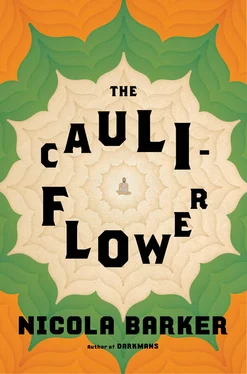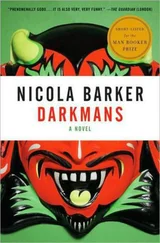A few days later Uncle was performing the arati in front of the Goddess. I was preparing lunch for Uncle, something very plain (Uncle was plagued by terrible indigestion; he constantly complained of a burning sensation in his chest), when suddenly a temple gardener — who has always held a soft spot for Uncle — came running across the main courtyard, calling out my name. I sprang up. “Is it Uncle?” I demanded. This poor man could hardly catch his breath. “I was delivering garlands to Ma Kali,” he panted, “and Gadai was causing a great commotion in the Temple. He was shouting at the Goddess. ‘What more can I do, Mother?’ he was screaming. ‘What more can I give you, Mother…?’ Then his eyes suddenly turned toward the ceremonial sword which is hung on the temple wall. ‘I shall give you my life!’ he cried, and then, before any person could stop him, he had grabbed this sword from its mount, unsheathed it, raised his arm with a bloodcurdling cry of ‘Mother!’ quite as if to stab himself with it, and then collapsed into a heap on the temple floor. We have tried our hardest to revive him, but nothing seems to be working. He has almost no pulse. And shows no sign of life. He is very deeply unconscious.”
We ran the length of the verandah together and then entered the Kali Temple through the back entrance. Outside the crowd of visitors and pilgrims stood many deep, craning their necks to see what was happening. And there we found Uncle Gadai, lying at the feet of Ma Kali, naked (Uncle’s wearing cloth abandoned), cushioned by a bed of flower offerings, deathly pale, a living Shiva, the unsheathed sword close by.
The temple administrator was already in attendance.
“What new madness is this?!” he demanded, “Your uncle has finally taken all leave of his senses!”
We kneeled down and gazed at Uncle. A small crowd had formed around him. An elderly woman, a widow, had somehow slipped past the guards and entered the temple sanctum and was stroking Uncle’s forehead with the hem of her white sari . “How beautiful this boy is!” she whispered, quite utterly beguiled by Uncle. “In all of my many years I swear that I have never seen a face as sweet and as radiant as his. Look! Look! See how he smiles!”
Uncle was indeed smiling. He wore a blissful expression. His young face, which had recently looked so thin and careworn, was now transformed. It was difficult for all of the people clustered around Uncle — even the temple administrator — not to sense the bewitching atmosphere of deep spiritual peace that Uncle now exuded.
It was very warm and close. The fragrance of sweet camphor and crushed flowers was overwhelming. Many eyes turned from Uncle’s glowing face toward the image of Kali which towered above us all. There was a brief silence (who can guess why?) and then a bright shaft of light passed from the shining basalt eyes of the black Goddess onto the naked boy with the moon face who lay offered — as if dead — before her. Perhaps this light was reflected from the blade of the ceremonial sword, which a guard had now retrieved and was placing back into its sheath? Who can say? But there was an audible gasp. “The image has awakened!” someone shouted; “This boy has awakened the Goddess!” cried another.
And then the widow began to clap her hands together, to rock and to chant: Ma, oh Ma, Ma go Ma! Jai Kali! Jai Kali Ma!
This cry was caught up by the ecstatic crowd as Uncle was lifted, still unconscious, and held aloft, pale and glowing, light as a feather. It continued, and at great volume, for many hours after Uncle had been carried back to his quarters. Not one of us spoke in the sanctum aside from the widow, however. Not one of us clapped and chanted. We were silent. We were perplexed. We were full of confusion and of awe.
1857. Gadadhar Chatterjee sighs and groans:
“The great hands of God
Are squeezing my restless heart
Like a wet towel!”
Aaaaaaargh!
It hurts! It hurts!
1885. Three years after a brief meeting with Navagopal Ghosh and his wife (in which Sri Ramakrishna tells Navagopal to find God through singing a kirtan daily), the Master suddenly thinks of them and asks a mutual acquaintance to tell them to come and see him again. They visit, astonished that he has remembered them; then Navagopal (who has faithfully chanted a kirtan every day since) and his wife, Nistarini, host a party for the Master. Many dishes are served to the Master, but as Nistarini presents him with his favorite desert (sandesh — a sweet, moist fudge made of cottage cheese) she is overwhelmed by a powerful urge.…
Sri Ramakrishna ( gazing at Nistarini intently, amused ): “What? You wish to feed me this sweet with your own hands?”
Nistarini ( astonished and embarrassed that the Master has read her thoughts, lowering her eyes, modestly ): “Yes, I would like to, very much.”
Sri Ramakrishna nods, then smiles, then opens his mouth. Nistarini picks up a small piece of the sweet and prepares to feed the Master with it — in much the same way one might make an offering of sweets to the image of a deity. She lifts her eyes and gazes into his open mouth, then gasps, appalled. Inside the Master’s throat she sees the head of a giant snake, jaws agape, waiting to receive the offering. This serpentlike creature she recognizes as the Master’s kundalini . She rapidly withdraws her hand, stops feeding the Master, and retreats. The Master slowly and quietly feeds himself, then kindly offers what remains on the plate back to the terrified Nistarini to be distributed as prasad among her many guests.
1885. Sri Ramakrishna meets a former devotee after a long interval. The former devotee admits that he has stopped visiting the guru because some of his newer devotees are now proclaiming him as the new messiah. Sri Ramakrishna just laughs, points to his throat, and croaks:
“They think I am God—
But their God has throat cancer.…
What fools they must be!”
A potted version of the crazy stand-up comedy life of one of Sri Ramakrishna’s most loyal and eccentric devotees: Durga Charan Nag
Durga Charan Nag, 1846–1899 (better known as Nag Mahashay, or Great-souled One), was training as a homeopathic doctor when he first visited Sri Ramakrishna at the Dakshineswar Kali Temple and Sri Ramakrishna became his guru (although Sri Ramakrishna would not tolerate the use of this word, obviously). He was one of Sri Ramakrishna’s householder disciples. These were men and women who were totally dedicated to God but who were nonetheless obliged to support the burden of wives, husbands, and families. This meant that they were tied to material concerns (running homes, earning wages, et cetera) and so could not fulfill their ultimate dream of giving up all worldly obligations to become itinerant monks.
Nag Mahashay celebrated a kind of faith called urjhita bhakti (or “exuberant devotion”) and had been this way from his early childhood. It was a state of mind completely natural to him. He would only talk about spiritual matters. If anyone spoke in Nag Mahashay’s company on issues that were not spiritual, he would instantly change the subject.
Nag Mahashay was so unbelievably humble that he would never contradict another person or speak a harsh word against anyone. A notable occasion on which he broke this rule (a show of irritation or loss of temper was contrary to the will of God, which is love , after all) resulted in him picking up a large stone and beating himself over the head with it until copious amounts of blood were drawn.
Nag Mahashay had been forced — by a strict and demanding father — to marry, even though this was against all his inclinations. His first wife died, and then his father forced him to marry again. His second wife was spiritually inclined and highly forbearing. Nonetheless, the young Nag Mahashay often made a habit of sleeping outside their home, perched on a low tree branch, so as to avoid jeopardizing his sexual virtue.
Читать дальше












